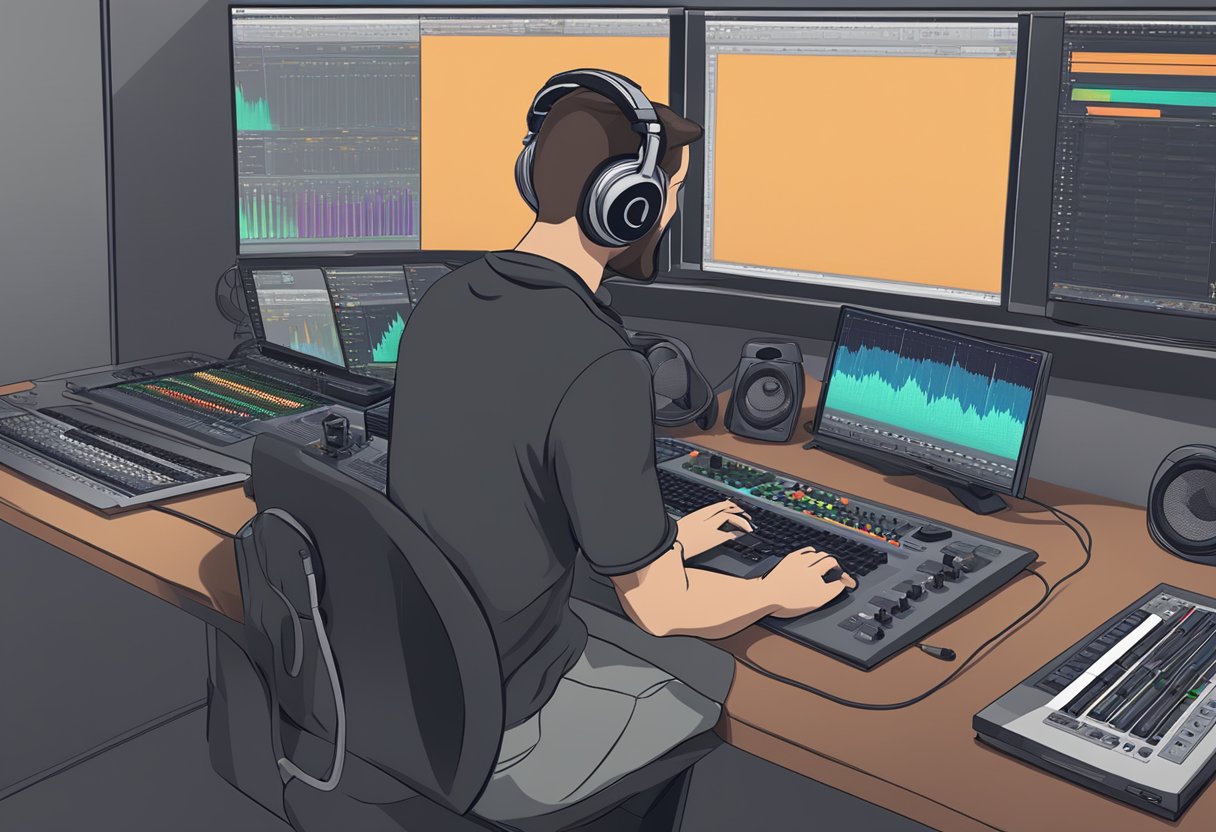Learning FL Studio can be a daunting task for beginners, but with the right resources and guidance, it can be a rewarding experience. FL Studio is a digital audio workstation (DAW) that offers a wide range of tools and features for music production. It is used by both amateur and professional musicians to create a variety of genres, from hip-hop and electronic music to rock and pop.

To get started with FL Studio, beginners can benefit from an FL Studio tutorial. There are many tutorials available online, ranging from basic introductions to more advanced techniques. These tutorials cover various aspects of FL Studio, such as MIDI settings, audio settings, and using VST/AU plugins. They are tailored to different levels of knowledge, from absolute beginners to experienced producers.
By following a FL Studio tutorial, beginners can learn how to navigate the software, create and edit patterns, arrange tracks, and mix and master their music. With practice and experimentation, they can develop their skills and create their unique sound. Whether you are an aspiring musician or a seasoned producer, learning FL Studio can open up new possibilities for your music production.
Getting Started with FL Studio
FL Studio is a popular digital audio workstation (DAW) that is widely used by music producers and enthusiasts. Whether you are a beginner or an experienced producer, FL Studio offers a wide range of features and tools to help you create professional-sounding music. In this section, we will cover the basics of getting started with FL Studio.
System Requirements
Before installing FL Studio, it is important to ensure that your computer meets the minimum system requirements. These requirements may vary depending on the version of FL Studio you are using. As of 2022, the minimum system requirements for FL Studio 20 are:
- Windows 7 or later (32 or 64-bit)
- 4GB of RAM or higher
- 4GB of free disk space
- Soundcard with DirectSound drivers
For a more detailed list of system requirements, refer to the official FL Studio Tutorial.
Installation and Setup
Once you have confirmed that your computer meets the system requirements, you can proceed with the installation of FL Studio. To install FL Studio, follow these steps:
- Download the installer from the official FL Studio website.
- Double-click the installer file to begin the installation process.
- Follow the on-screen instructions to complete the installation.
After installing FL Studio, you will need to set up your audio devices and configure the audio settings. This will ensure that you can hear and record audio within FL Studio.
Understanding the Interface
FL Studio has a user-friendly interface that is designed to help you navigate its various features and tools. The interface is divided into several sections, including the Browser, Channel Rack, Playlist, Mixer, and Piano Roll.
The Browser is where you can access your audio files, plugins, and presets. The Channel Rack is where you can create and manage your instrument and effect channels. The Playlist is where you can arrange your patterns and create your song structure. The Mixer is where you can adjust your channels’ volume, panning, and effects. The Piano Roll allows you to edit your MIDI notes and create melodies.
Configuring Audio Settings
Before you start creating music in FL Studio, it is important to configure your audio settings. This will ensure that you can hear and record audio within FL Studio. To configure your audio settings, follow these steps:
- Open the Options menu and select Audio Settings.
- Select your audio device from the Input/Output section.
- Set the Buffer length to a low value to reduce latency.
- Set the Sample rate to match the sample rate of your audio files.
- Test your audio settings by playing back a project or recording audio.
In conclusion, getting started with FL Studio is easy. By following these basic steps, you can begin creating your music in no time.
Basic Operations
Learning the basic operations of FL Studio is essential for any beginner. This section will cover the fundamental operations of FL Studio that will help you get started with the software.
Creating a New Project
To create a new project in FL Studio, go to the File menu and select New. Alternatively, you can press Ctrl+N on your keyboard. This will open a new project with a default template. You can also create a new project using a template by selecting File > New from the template.
Using the Browser
The Browser is a powerful tool in FL Studio that allows you to navigate your files, samples and presets. To open the Browser, click on the icon on the top left of the screen or press F8 on your keyboard. You can then use the Browser to browse for files, samples, and presets.
Navigating the Playlist
The Playlist is where you arrange and sequence your patterns and audio clips. To open the Playlist, click on the Playlist icon on the top right of the screen or press F5 on your keyboard. You can then use the Playlist to add, delete, and arrange patterns and audio clips.
Working with the Channel Rack
The Channel Rack is where you create and edit your patterns. To open the Channel Rack, click on the Channel Rack icon on the top left of the screen or press F6 on your keyboard. You can then use the Channel Rack to create and edit patterns using the Piano Roll or Step Sequencer.
Understanding the Mixer
The Mixer is where you mix and process your audio. To open the Mixer, click on the Mixer icon on the top right of the screen or press F9 on your keyboard. You can then use the Mixer to adjust the volume, panning, and effects of each track in your project.
By understanding these basic operations of FL Studio, you will be able to create your music and improve your production skills. For more detailed information on FL Studio, check out the FL Studio Tutorial website.
MIDI and Instruments
FL Studio is a digital audio workstation that offers a range of options for creating music. MIDI and instruments are an essential part of the software, and understanding how to use them is crucial for producing high-quality tracks. In this section, we will cover the basics of MIDI and instruments in FL Studio.
Adding Instruments
Adding instruments to a project is a straightforward process in FL Studio. Users can choose from a variety of built-in plugins or use third-party plugins. To add an instrument, navigate to the channel rack and click the “+” icon. From there, select “Add” and choose the desired instrument. FL Studio also allows users to save their own presets, making it easy to access frequently used plugins.
MIDI Setup and Recording
MIDI is a protocol that allows devices to communicate with each other. In FL Studio, MIDI can be used to control instruments, record notes, and automate parameters. To set up MIDI in FL Studio, navigate to the MIDI settings in the options menu. From there, users can select their MIDI device and configure the input and output settings.
Recording MIDI in FL Studio is a simple process. Users can arm a MIDI track for recording and then use their MIDI device to play notes. The notes will be recorded in real time, and users can edit them in the piano roll.
Using the Piano Roll
The piano roll is a powerful tool in FL Studio that allows users to compose melodies and edit MIDI data. Users can access the piano roll by double-clicking on a MIDI clip in the playlist. From there, users can draw in notes, adjust the velocity and length of notes, and add automation data.
Programming Drums
Programming drums in FL Studio is a popular technique for creating drum tracks. FL Studio offers a variety of drum samples and plugins, making it easy to create realistic drum sounds. Users can program drums using the step sequencer or the piano roll. The step sequencer is a grid-based interface that allows users to quickly program drum patterns, while the piano roll offers more detailed editing options.
Overall, MIDI and instruments are essential components of FL Studio. By understanding how to use them, users can create high-quality tracks and bring their musical ideas to life. For more information on using FL Studio, check out the FL Studio Tutorial.
Audio Recording and Editing
FL Studio is a powerful digital audio workstation that offers a range of tools for recording and editing audio. Whether you are recording vocals, live instruments, or electronic sounds, FL Studio has the tools you need to create professional-sounding tracks.
Recording Audio
Recording audio in FL Studio is a straightforward process. Simply connect your microphone or instrument to your computer’s audio interface, select the appropriate input in the mixer, and hit the record button. FL Studio supports both internal and external recording, so you can record from your computer’s sound card or an external source.
Editing Audio Clips
Once you have recorded your audio, FL Studio offers a range of editing tools to help you fine-tune your recordings. You can use the playlist editor to arrange your clips, cut and splice audio with the slice tool, and adjust the volume and panning of individual clips. You can also use the channel rack to add effects and automate parameters for more creative control.
Time Stretching and Pitch Shifting
FL Studio includes powerful time-stretching and pitch-shifting tools that allow you to adjust the timing and pitch of your recordings. You can use the time stretching tool to slow down or speed up your recordings without changing the pitch, or use the pitch shift tool to transpose your recordings up or down in pitch.
Using Edison for Detailed Editing
For more detailed editing, FL Studio includes Edison, a powerful audio editor that allows you to edit audio at the sample level. With Edison, you can zoom in on your audio, add markers, and make precise cuts and edits. You can also use Edison to remove unwanted noise from your recordings and clean up your audio.
Overall, FL Studio offers a range of powerful tools for recording and editing audio. Whether you are a beginner or an experienced producer, FL Studio’s intuitive interface and powerful features make it an excellent choice for creating professional-sounding tracks.
Mixing and Effects
Mixing and Effects are essential parts of producing high-quality music in FL Studio. This section will cover some of the basic concepts of mixing and applying effects in FL Studio.
Basic Mixing Concepts
Mixing is the process of combining multiple audio tracks into a single stereo or mono track. The goal of mixing is to create a balanced and polished sound by adjusting the levels, panning, and equalization of each track. In FL Studio, all audio passes through the Mixer, which allows you to adjust the levels of each track and apply various effects.
To mix tracks in FL Studio, you can use the Mixer’s faders, which control the volume of each track, and the pan knobs, which control the stereo position of each track. You can also use the EQ knobs to adjust the frequency balance of each track, and the send knobs to send a portion of a track’s audio to an effect bus.
Applying Effects
Effects are used to shape and enhance the sound of individual tracks or the overall mix. FL Studio includes a wide range of effects, including reverb, delay, distortion, and compression. To apply an effect to a track, you can use the Mixer’s Insert Tracks, which allow you to insert plugins and route audio to them.
To apply an effect to the overall mix, you can use the Master Track, which allows you to apply effects to the entire mix. You can also use automation clips to control the parameters of an effect over time.
Automation Clips
Automation clips allow you to control the parameters of a track or effect over time. You can use automation clips to create dynamic changes in the mix, such as volume fades, filter sweeps, and panning effects. To create an automation clip, you can right-click on a knob or fader and select “Create automation clip.”
Sidechain Compression
Sidechain compression is a technique used to create a “pumping” effect in the mix. It involves using a compressor to reduce the volume of one track when another track is playing. This technique is often used in electronic dance music to create a rhythmic effect.
In FL Studio, you can use the Fruity Limiter plugin to apply sidechain compression. To do this, you can route the audio from the track you want to compress to the sidechain input of the Fruity Limiter plugin on the track you want to trigger the compression. You can then adjust the settings of the Fruity Limiter to create the desired effect.
Overall, understanding the basics of mixing and effects is essential for producing high-quality music in FL Studio. By using the Mixer, Insert Tracks, and Master Track, you can create a balanced and polished sound. By applying effects and using automation clips, you can add depth and dynamics to your mix. Finally, by using sidechain compression, you can create rhythmic effects that add energy to your music.
Mastering
Mastering is the process of enhancing the final mix of a track to make it sound polished and professional. In FL Studio, there are many tools and plugins available for mastering. This section will cover the fundamentals of mastering, using mastering plugins, and finalizing your track.
Mastering Fundamentals
Before diving into using mastering plugins, it is essential to understand the fundamentals of mastering. The goal of mastering is to make the track sound better without changing the original mix’s character. This process involves adjusting the track’s volume, EQ, compression, and stereo width.
It is important to start by setting the correct levels. This involves adjusting the volume of each track in the mix to ensure that they are balanced. The next step is to use an EQ to adjust the frequency balance of the mix to make it sound more cohesive. Compression is then used to control the dynamic range of the mix and make it sound more consistent. Finally, the stereo width is adjusted to make the mix sound more spacious.
Using Mastering Plugins
FL Studio comes with many built-in mastering plugins that can be used to enhance the final mix. These plugins include the Fruity Limiter, Fruity Parametric EQ 2, and Fruity Stereo Shaper.
The Fruity Limiter is a powerful tool for controlling the dynamic range of the mix. It can be used to increase the overall volume of the mix while preventing clipping. The Fruity Parametric EQ 2 is used to adjust the frequency balance of the mix. It has many features, including a spectrum analyzer and a visual EQ display. The Fruity Stereo Shaper is used to adjust the stereo width of the mix.
Finalizing Your Track
Once you have used the mastering plugins to enhance the final mix, it is time to finalize the track. This involves exporting the track in the correct format and ensuring that it is ready for distribution.
When exporting the track, it is important to select the correct file format and bit depth. The most common format for distributing music is MP3, but other formats such as WAV and FLAC are also used. The bit depth should be set to 16-bit or 24-bit, depending on the intended use.
In conclusion, mastering is an essential part of the music production process. With FL Studio’s built-in mastering plugins and a solid understanding of the fundamentals, anyone can create a professional-sounding track.
Exporting and Sharing
FL Studio is a powerful digital audio workstation that allows users to create professional-quality music. Once you have completed your project, it is important to know how to export and share your final mix. This section will cover the different options for exporting and sharing your music in FL Studio.
Exporting Your Final Mix
Exporting your final mix is a crucial step in the music production process. In FL Studio, you can export your project in a variety of formats, including WAV, MP3, OGG, and FLAC. To export your final mix, click on File > Export > Audio. This will bring up the Export Audio dialog box, where you can select your desired format and bitrate.
It is important to choose the right format and bitrate for your final mix. WAV files are uncompressed and offer the highest quality, but they also take up a lot of disk space. MP3 files are compressed and take up less space, but they also have a lower quality. OGG and FLAC files are compressed and offer a high quality, but they are not as widely supported as WAV and MP3 files.
When exporting your final mix, it is also important to pay attention to the volume levels. You want to make sure that your mix is not too quiet or too loud. FL Studio has a built-in limiter that can help you control the volume levels and prevent clipping.
Sharing to Online Platforms
Once you have exported your final mix, you can share it with online platforms such as SoundCloud, YouTube, and Facebook. To share your music on these platforms, you will need to create an account and upload your file. It is important to choose the right platform for your music and to promote your music on social media to reach a wider audience.
FL Studio also allows you to export your project as a Zipped Loop Package, which contains all the files used in your project. This can be useful if you want to collaborate with other producers or send your project to a mastering engineer. To export your project as a Zipped Loop Package, click on File > Export > Zipped Loop Package.
In conclusion, exporting and sharing your final mix is an important part of the music production process. FL Studio offers a variety of options for exporting your music and sharing it to online platforms. By following the right steps and paying attention to the details, you can ensure that your music sounds great and reaches a wider audience.
Advanced Techniques
Once you have mastered the basics of FL Studio, it’s time to move on to more advanced techniques. In this section, we will cover some of the most important advanced techniques that will take your production skills to the next level.
Advanced MIDI Techniques
MIDI is an essential part of electronic music production, and understanding advanced MIDI techniques is crucial for creating complex and dynamic tracks. FL Studio offers a wide range of MIDI tools and features that can help you achieve your creative vision.
One advanced MIDI technique is the use of MIDI controllers. These devices allow you to control various parameters of your tracks in real time, such as pitch, velocity, and modulation. FL Studio supports a wide range of MIDI controllers, so you can find one that suits your needs and preferences.
Another advanced MIDI technique is the use of MIDI scripting. This allows you to create custom MIDI scripts that automate repetitive tasks and streamline your workflow. FL Studio has a powerful scripting engine that can help you create complex MIDI scripts with ease.
Sound Design with Synthesizers
Sound design is an essential part of electronic music production, and FL Studio offers a wide range of synthesizers and sound design tools to help you create unique and innovative sounds. One of the most popular synthesizers in FL Studio is Harmor, which offers advanced additive synthesis capabilities and a wide range of modulation options.
Another popular synthesizer in FL Studio is Serum, which offers wavetable synthesis and a wide range of filter and modulation options. With these tools, you can create complex and dynamic sounds that will take your tracks to the next level.
Creative Sampling
Sampling is an essential part of electronic music production, and FL Studio offers a wide range of sampling tools and features to help you create unique and innovative tracks. One advanced sampling technique is the use of granular synthesis, which allows you to manipulate and transform samples in creative and unexpected ways.
Another advanced sampling technique is the use of time-stretching and pitch-shifting. This allows you to manipulate the tempo and pitch of your samples, creating unique and interesting effects that can add depth and dimension to your tracks.
Collaboration and Project Management
Collaboration and project management are essential skills for any electronic music producer, and FL Studio offers a wide range of tools and features to help you collaborate with other producers and manage your projects more effectively. One useful feature in FL Studio is the ability to export stems, which allows you to share individual tracks with other producers and collaborators.
Another useful feature of FL Studio is the ability to create and manage multiple versions of your project. This allows you to experiment with different ideas and approaches without losing your original work. With these tools, you can collaborate with other producers and manage your projects more effectively, ensuring that your tracks are the best they can be.
In conclusion, mastering advanced techniques in FL Studio can take your production skills to the next level. By understanding advanced MIDI techniques, sound design with synthesizers, creative sampling, and collaboration and project management, you can create unique and innovative tracks that stand out from the crowd.
Troubleshooting and Support
FL Studio is a powerful digital audio workstation that offers a wide range of features and tools. However, like any software, it can sometimes encounter problems. This section will cover some common issues and solutions, how to update FL Studio, and how to access technical support.
Common Issues and Solutions
If you are experiencing issues with FL Studio, it is important to first check the knowledge base and frequently asked questions (FAQ) on the official FL Studio website. Many common issues have simple solutions. For example, if you are experiencing audio dropouts, you may need to increase your buffer size. If you are having trouble with plugins, you may need to scan for them in the plugin manager.
Another common issue is the “blue screen of death” (BSOD) on Windows computers. This can be caused by a variety of factors, including outdated drivers or conflicting software. One solution is to update your drivers and ensure that FL Studio is the only software running when you are using it.
Updating FL Studio
Updating FL Studio is important for ensuring that you have access to the latest features and bug fixes. To update FL Studio, simply download the latest version from the official website and run the installer. Be sure to save your projects before updating, as some updates may cause compatibility issues with older projects.
Accessing Technical Support
If you are still experiencing issues with FL Studio, you may need to contact technical support. The official FL Studio website offers a variety of support options, including a knowledge base, user forums, and a ticketing system for direct support. When submitting a support ticket, be sure to include as much information as possible about the issue, including any error messages or steps to reproduce the problem.
In addition to official support, there are also many third-party resources available for learning FL Studio and troubleshooting issues. These include FL Studio tutorials on YouTube and other websites, as well as user forums where you can ask for help from other FL Studio users.
Overall, troubleshooting and support are important aspects of using FL Studio. By staying up-to-date with the latest updates and resources, users can ensure that they are getting the most out of this powerful software.


